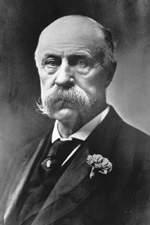|
J. C. S. Blackburn
Joseph Clay Stiles Blackburn (October 1, 1838 – September 12, 1918) was an American politician and lawyer who was a Democratic U.S. Representative and Senator from Kentucky and Governor of Panama Canal Zone. A skilled and spirited orator, he was a prominent trial lawyer known for his skill at swaying juries.[1] Biography Blackburn was born on October 1, 1838, near Spring Station, Kentucky.[1] He was the younger brother of Kentucky governor Luke P. Blackburn.[2] He attended Sayres Institute in Frankfort and graduated from Centre College in Danville in 1857. He studied law in Lexington and was admitted to the bar in 1858. He practiced in Chicago until 1860 when he returned to Woodford County, Kentucky, and entered the Confederate Army as a private in 1861.[1] A staff officer, by the end of the Civil War Blackburn had attained the rank of lieutenant colonel. After the war he settled in Arkansas, where he was engaged as a lawyer and a planter in Desha County until 1868 when he returned to Kentucky and opened law offices in Versailles.[1] He was a member of the State house of representatives from 1871 to 1875. He was then elected as a Democrat to the Forty-fourth and to the four succeeding Congresses (March 4, 1875 - March 3, 1885). He was the chairman of the Committee on the District of Columbia (Forty-fifth Congress) and the Committee on Expenditures in the Department of War (Forty-fifth and Forty-sixth Congresses). In 1885, U.S. Army Lt. Henry T. Allen named a mountain after Joseph Blackburn. Mount Blackburn is the highest peak in the Wrangell Mountains of the state of Alaska and the fifth highest peak in the United States.[1] He was elected to the United States Senate in 1884, was reelected in 1890, and served from March 4, 1885, to March 3, 1897. He failed to be reelected in 1896. He was the chairman of the Committee on Rules (Fifty-third Congress). He was once again elected to the United States Senate in 1900 and served from March 4, 1901, to March 3, 1907, but failed in his next election bid in 1906.[3] Loosely associated with the free-silver wing of the Democratic party, he was well known nationally and his name was placed in nomination for the presidency in 1896.[1] He was appointed Governor of the Panama Canal Zone by President Theodore Roosevelt on April 1, 1907. He resigned and returned to his estate in Woodford County.[1] He died on September 12, 1918, in Washington, D.C. He was interred in the State Cemetery in Frankfort.[1] References
Further reading
External links
|
||||||||||||||||||||||||||||||||||||||||||||||||||||||||||||||


